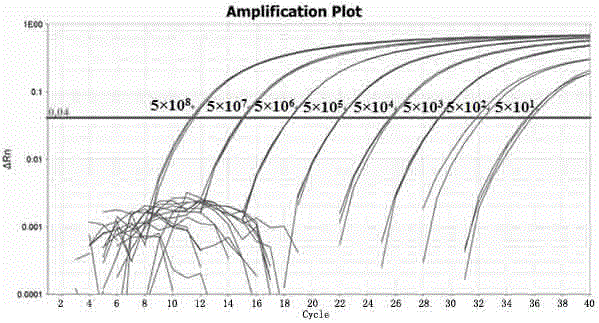Fluorogenic quantitative PCR detection kit for melissococcus pluton and detection method thereof
A detection kit and fluorescence quantitative technology, applied in the direction of microorganism-based methods, microorganism measurement/inspection, biochemical equipment and methods, etc., can solve the problems of detection methods that have not been reported, and achieve simple operation, high sensitivity, good repeatability
- Summary
- Abstract
- Description
- Claims
- Application Information
AI Technical Summary
Problems solved by technology
Method used
Image
Examples
Embodiment 1
[0032] A fluorescent quantitative PCR detection kit for Melissa officinalis, comprising a forward primer F, a reverse primer R and a TaqMan probe P, wherein the sequence of the forward primer F is 5'-AACGCTTCTTCTGATTAAG-3', and the sequence of the reverse primer R is 5' '-GCCTTTTAACTCCCTCTTC-3'; TaqMan probe P sequence is 5'-FAM-ACGGTATTAGCACCTGTTTCCAAAT-BHQ1-3'. The kit includes the following reagents (50 reactions):
[0033] (1) Positive standard: Use F and R primers to amplify the genomic DNA of Melissa melissae, clone the product into the pMD-18T vector, transform DH5α Escherichia coli, extract the positive clone plasmid by alkaline lysis, and calculate the purity and concentration of the plasmid. 10-fold serial dilution to 1000 copies / μL as a positive standard, 100 μL / vial, stored at -20 °C;
[0034] (2) Negative control: 1 negative control with a concentration of 100 ng / μL in 100 μL, and the total DNA extracted from healthy bee tissues not infected with Melilococcus hiv...
Embodiment 2
[0039] The detection method using the honeycomb melissa officinale fluorescent quantitative PCR detection kit comprises the following steps:
[0040] (1) PCR reaction system configuration: Add 17.0 μL of PCR reaction solution, 0.5 μL of 5 U / μL ExTaq enzyme, 2.0 μL of sample DNA to be tested into the PCR tube, and then add 5.5 μL of sterilized water to make the total reaction volume 25.0 μL ;
[0041] (2) PCR reaction program: pre-denaturation at 95°C for 3 min; then denaturation at 95°C for 5 s, annealing and extension at 59°C for 30 s, a total of 40 cycles, and single-point fluorescence detection at 59°C;
[0042] (3) Judgment of results: The negative control has no Ct value and no amplification curve, while the positive control has a Ct value ≤ 35 and a typical amplification curve, indicating that the experiment is valid, otherwise the experiment is invalid. If the experiment is valid, the sample to be tested has no Ct value and no amplification curve, indicating that the s...
Embodiment 3
[0044] Establishment of Standard Curve for Fluorescent Quantitative PCR Detection Kit of Apis coccus in Apiary
[0045] (1) Standard DNA dilution: Dilute the positive clone plasmid containing the target fragment 10 times with sterile water to 5×10 8 Copies / μL ~5×10 1 A range of DNA standards in copies / µL.
[0046] (2) Establishment of the standard curve equation: the diluted DNA standard was used as the template, and each standard sample was treated 3 times, and the total DNA of healthy bee tissues not infected with Melilococcus hives was used as the control, and sterile water was used as the blank control . The fluorescent quantitative PCR reaction system of 25 μ L is configured in the manner described in Example 2 and carried out fluorescent quantitative PCR reaction; figure 2 The amplification curve shown is then plotted as image 3 For the standard curve shown, construct the standard curve equation. The standard curve equation constructed in this embodiment is Y=-3.3...
PUM
 Login to View More
Login to View More Abstract
Description
Claims
Application Information
 Login to View More
Login to View More - R&D Engineer
- R&D Manager
- IP Professional
- Industry Leading Data Capabilities
- Powerful AI technology
- Patent DNA Extraction
Browse by: Latest US Patents, China's latest patents, Technical Efficacy Thesaurus, Application Domain, Technology Topic, Popular Technical Reports.
© 2024 PatSnap. All rights reserved.Legal|Privacy policy|Modern Slavery Act Transparency Statement|Sitemap|About US| Contact US: help@patsnap.com










